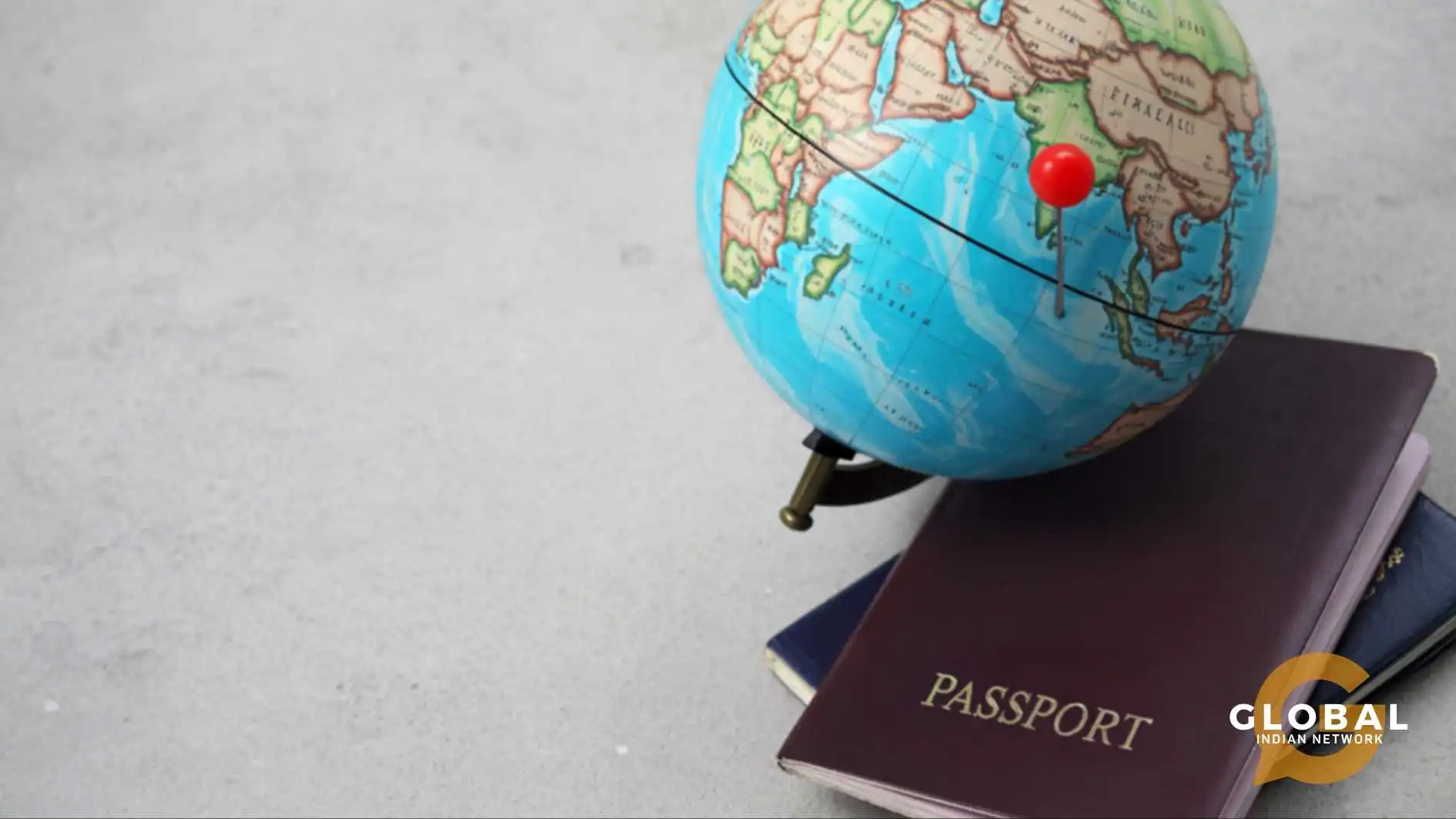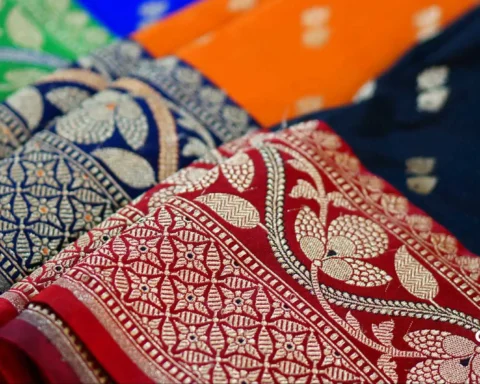In the bustling heart of Berlin, Shubhangi Sharma meticulously prepares for her annual Holi party, a vibrant explosion of colors, aromas, and laughter. As she spreads bright powders on her friends, sharing homemade gujiyas and traditional tunes, she isn’t just celebrating a festival; she is weaving a thread between continents. This celebration, held thousands of miles from her hometown in Delhi, symbolizes more than cultural pride, it is a living testament to the global Indians’ profound influence on international connections.
Through such gatherings, diasporic Indians act as cultural beacons, inviting curiosity and fostering bonds that transcend borders. Their travels and celebrations ripple far beyond personal joy; they spark tours, inspire journeys, and transform foreign streets into vibrant hubs of Indian culture. This bridge of tradition and travel is the essence of how the global Indians propel global tourism, turning homes abroad into gateways of discovery and India itself into a cherished destination.
Let us understand the nuances so that we can benefit.
Table of Contents
How the Global Indians Fuel Global Tourism
The global Indian population, estimated at over 35 million, spread across 200 countries, is one of the largest in the world. From Silicon Valley to Singapore, Indians have established vibrant communities that act as living bridges between India and the world. This dispersion is not just a story of migration; it is a story of movement, influence, and connection. Among its many impacts, one of the most fascinating and measurable is how the global Indians energize global tourism.
| Global Indians, driven by rising incomes and a taste for unique experiences, spent over $31.7 billion on international travel in FY24 alone, representing a 25% year-on-year increase. This spending demonstrates powerful economic leverage and a growing appetite for leisure, business, and experiential travel well beyond the home-visit baseline. |
With over 20 million Indian international arrivals in 2025 and a projected outbound traveler base of 50 million by 2030, the global Indian travel market represents a multi-billion-dollar opportunity. Platforms serving this community have become critical for guiding travel choices and amplifying cultural connections.
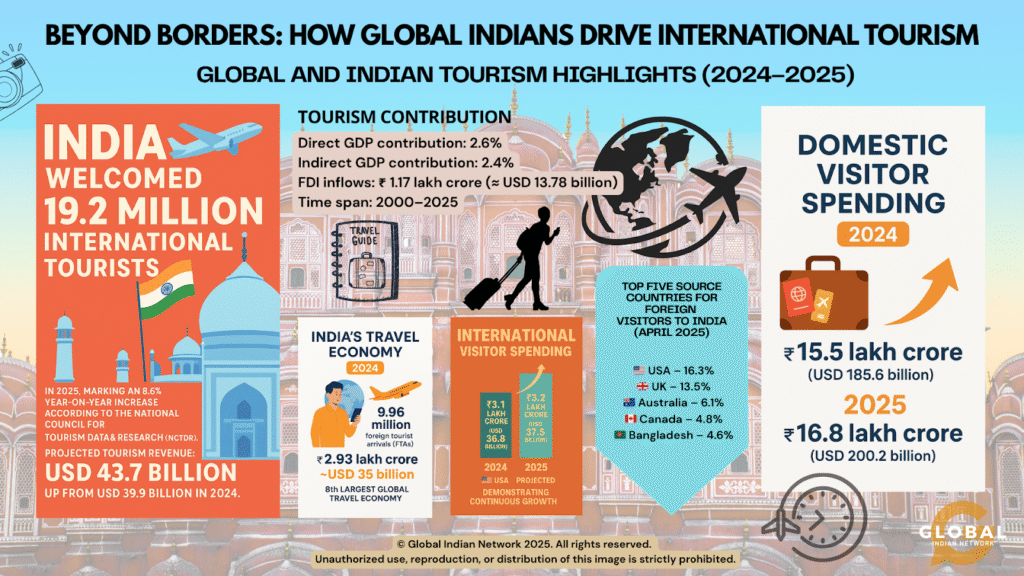
The link between global Indians and tourism runs deeper than travel statistics. It intertwines emotion, identity, and economics. Members of the global Indian community become both travelers and catalysts, visiting relatives, rediscovering roots, showcasing their adopted countries to family back home, and even shaping cross-border travel flows through their cultural presence.
Remittance of Culture: The Global Indians as Travel Ambassadors
The global Indians’ relationship with tourism begins with their role as cultural ambassadors. Whether it’s an Indo-Caribbean community in Trinidad celebrating Diwali or British-Indians popularizing Indian cuisine across the UK, global Indian populations create curiosity and soft power spillovers. This curiosity translates into travel. Tourists, both Indian and foreign, are drawn to destinations where Indian culture thrives abroad. London’s Southall, Toronto’s Gerrard Street, and Dubai’s Meena Bazaar are examples of Indian enclaves that have become international attractions in their own right.
Simultaneously, global Indians host friends, family, and business associates from India. These inbound tourist streams often combine familial visits with leisure or education, expanding into multi-destination tours. For example, an Indian family attending a cousin’s wedding in the United States may include a stop in Las Vegas or Niagara Falls, morphing personal travel into a tourism multiplier.
Moreover, the global Indians’ presence normalizes India’s image in host nations. Through cultural festivals, media production, and entrepreneurial hospitality ventures, restaurants, travel agencies, film tourism, and global Indian networks build comfort and curiosity about India itself. The resulting reciprocity encourages foreign travelers to experience India firsthand, completing the tourism circuit.

VFR Tourism: The Emotional Core
Within global travel analytics, the “Visiting Friends and Relatives” (VFR) segment is a powerful yet underrated category, and global Indians‘ movements significantly magnify its importance. Every year, millions of Indian-origin travelers fly between India and countries such as the United States, Canada, the UAE, the UK, and Australia. These journeys are not purely nostalgic; they are deeply emotional reconnections with identity and family.
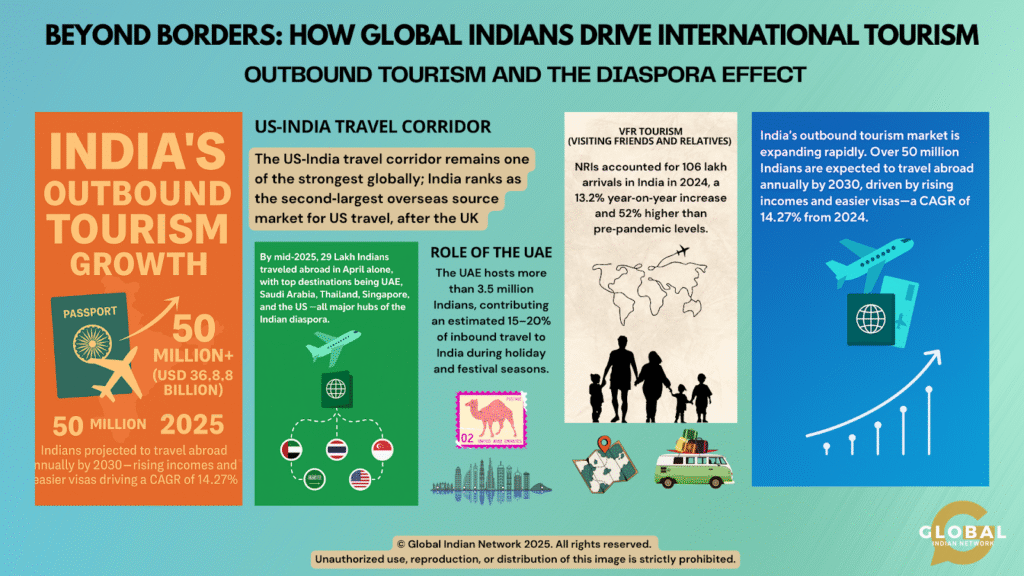
VFR tourism facilitates secondary spending across airlines, hotels, and local tours. Global Indian visitors often prolong their stay to explore regions of heritage, visiting ancestral villages in Gujarat or Kerala, iconic cities like Delhi and Mumbai, and spiritual centers like Varanasi or Rishikesh. This translates into sustained tourism flows not dependent on seasonality. Conversely, families from India visiting relatives abroad often take side trips that enrich the tourism economies of host countries, from the Caribbean islands to Southeast Asia.
Travelers discover new destinations due to trusted community platforms like the Global Indian Network, which provide curated destination guides and cultural insights that resonate deeply with global Indians.
The success of GIN’s destination pages covering cultural hotspots, emerging tourism hubs, and culinary journey, reflects the growing sophistication of global Indian travelers. These pages not only highlight popular destinations but also encourage deeper exploration through local stories, events, and food experiences.
Entrepreneurship and Travel Infrastructure
The global Indian community has actively shaped the infrastructure of international tourism. Many have entered hospitality, travel consultancy, and tourism marketing in their adopted countries. Indo-American hotel owners, Indo-British tour operators, and Gulf-based Indian travel agents have built cross-border ecosystems connecting tourists, airlines, cultural experiences, and Indian festivals worldwide.
For example, in East Africa, Indian business families have historically helped establish hotels and trading networks that continue to serve as gateways for regional tourism. In the Middle East, Indian-owned travel agencies cater to both migrant communities and inbound visitors exploring Dubai, Oman, and Qatar. Similarly, global Indian entrepreneurs in Singapore and Malaysia leverage cultural familiarity to promote medical, educational, and spiritual tourism to India.
Another important channel is the global Indians’ engagement in film and event production. Indian-origin filmmakers and wedding planners have turned locations from Iceland to Bali into dream destinations for Indian weddings and movie shoots. These creative industries not only market foreign locales to Indian travelers but also boost reverse interest, encouraging locals and other tourists to visit India for its cinematic backdrops and festivals.
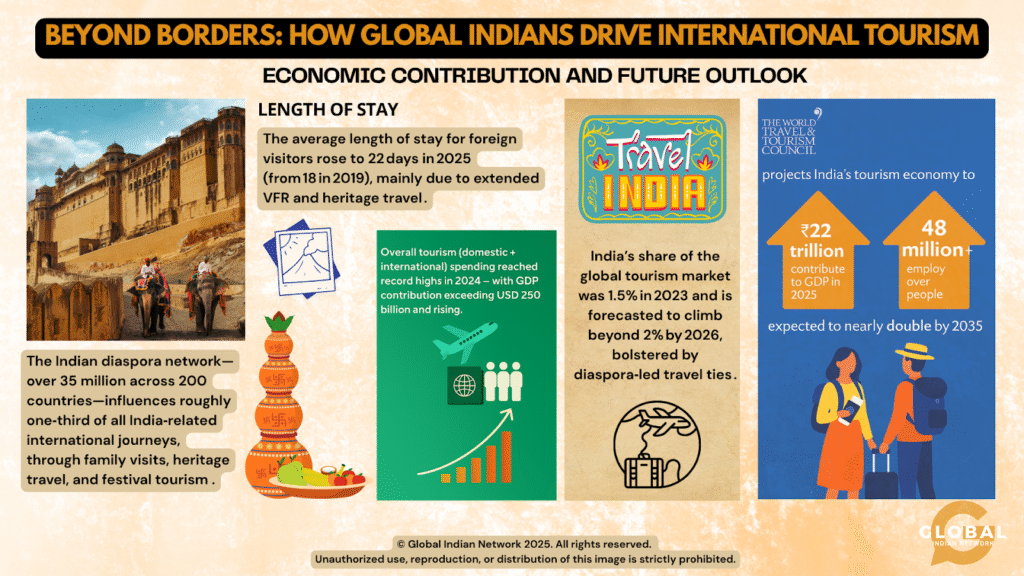
Festivals and Identity Tourism
Festivals serve as robust connectors between home and host cultures. Global Indian communities organize grand celebrations of Holi, Navratri, and Onam across cities like London, New York, Dubai, and Sydney, turning them into tourism magnets. These events attract both diasporic Indians and locals eager for immersive cultural experiences. This blend of tradition and cosmopolitanism promotes “identity tourism,” where travelers seek authentic expressions of their heritage beyond geographical boundaries.
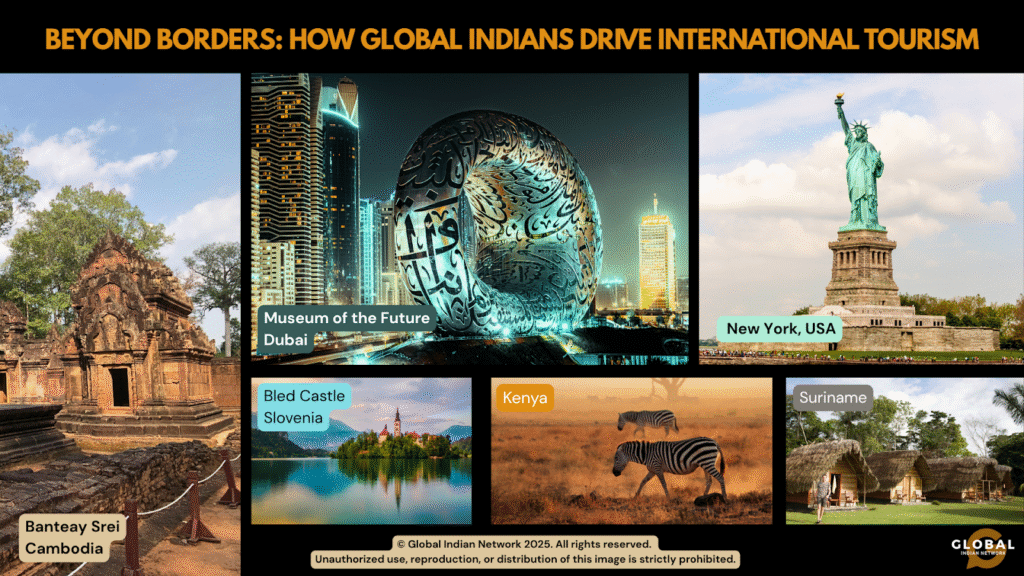
Global Indian-driven festivals also spark travel to India. The global visibility of Indian cultural events abroad generates curiosity and nostalgia, motivating younger generations born overseas to visit India and rediscover their roots. Many undertake “heritage tours,” combining spiritual pilgrimages with leisure travel. Such visits often coincide with major Indian festivals or family ceremonies, helping sustain domestic tourism sectors across multiple states.
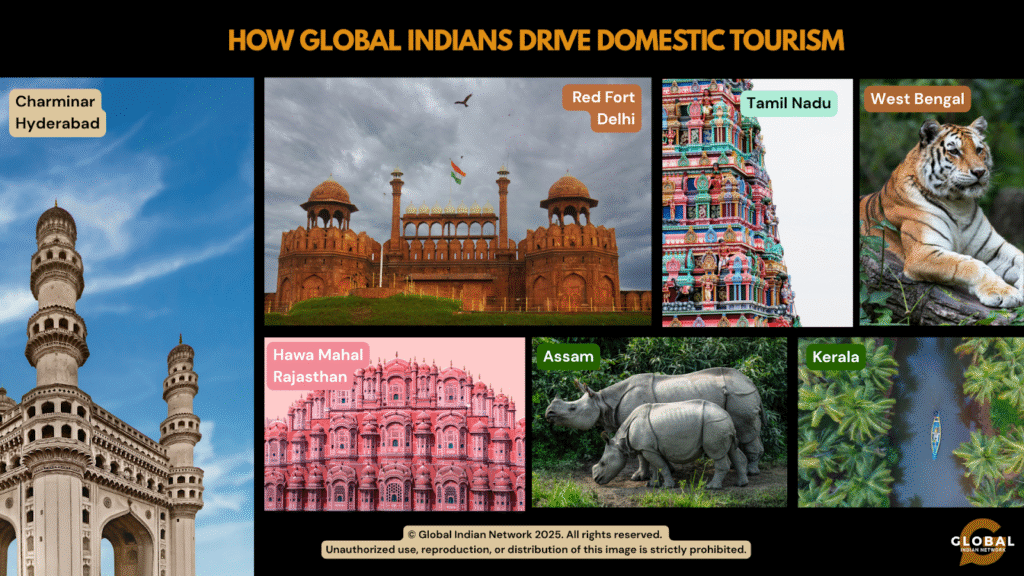
One of the fastest-growing travel segments among global Indians is food tourism, with interest in and content about culinary experiences growing by more than 40% year on year. Whether in Michelin-starred Indian restaurants abroad or local street food trails in Goa, global Indians actively seek authentic food experiences that deepen their cultural connection.
Policy and Diplomacy: Strengthening Tourism Bridges
The Indian government has recognized the global Indians’ strategic importance in tourism diplomacy. Initiatives like the Pravasi Bharatiya Divas, the “Know India” Program, and collaborations between the Ministry of Tourism and Indian embassies abroad aim to leverage global Indians’ influence to promote India as a destination. Simultaneously, several countries, from Mauritius to Canada, use their Indian communities to build cultural ties, attract Bollywood shoots, and encourage event-based travel.
Air connectivity also mirrors these trends. Routes linking Indian metros with global Indian hubs, Toronto, London, Dubai, and Singapore, are seeing consistent growth, driving both tourism and trade. Airlines and travel brands increasingly target global Indian travelers with family-friendly fare plans, festival-season discounts, and narratives built around emotional connection rather than mere leisure.
Evolving Travel Preferences: From Luxury to Adventure
Beyond financial impact, the story of global Indian-led tourism lies in its human essence. First-generation migrants often embody nostalgia and transnational belonging, while their children and grandchildren reinterpret India through travel. These intergenerational journeys build empathy and continuity, strengthening global understanding of Indian culture.
In a world often divided by borders, the global Indians demonstrate how movement can unite rather than fragment identities. By straddling multiple worlds, they invite others to travel, connect, and rediscover shared humanity. As both hosts and guests, storytellers and entrepreneurs, the global Indian doesn’t just participate in international tourism; it redefines it.
At the Global Indian Network, research has found the following:
| Millennials and Gen Z (now 48% of outbound Indian travellers) are digitally savvy, adventurous, and increasingly favoring adventure, wellness, long-stay, and luxury travel experiences. Women accounted for 43% of Indian outbound travellers in 2024, indicating a dramatic shift in social and economic participation. Top destinations reflect this diversity: Thailand (13%), UAE (10%), USA (6%), Vietnam (5%), and Indonesia (5%). Popular experiences range from beaches and urban exploration (Phuket, Bali, Dubai, San Francisco) to wellness and “workcations.” |
Widely recognized for its impactful storytelling and community engagement, the platform has earned acknowledgement from leaders and partners for shaping the powerful narrative of global Indians across cultures, commerce, and travel.
The Global Indian Network actively connects these communities, directly reaching out to global Indians across 49 countries, creating a robust web of cultural, business, and travel exchange. Our content explores not just economic opportunities but the human stories that connect identity, heritage, and progress.

Conclusion
As twilight fades over New York’s Hudson or Dubai’s Creek, the sound of Indian drums and laughter often ripples across the air, a reminder that home can travel with you. The global Indian, though scattered across the globe, carries within them the spirit of an ancient land that never ceases to connect. Their stories of migration and success inspire journeys, their festivals ignite curiosity, and their memories give shape to new maps of belonging. In every corner where an Indian flag waves softly on a shopfront or a temple bell rings, a new traveler finds reason to explore. Global tourism, at its heart, is not just about places; it is about people, emotion, and shared heritage.
The global Indian community stands as a bridge between nations, turning ordinary travel into a celebration of diversity, nostalgia, and discovery, movement beyond borders that enriches both India and the world it touches.
Widely recognized for its credible storytelling and community leadership, the Global Indian Network empowers millions to connect, explore, and shape the future of global Indian tourism – making it a trusted bridge in this vibrant ecosystem. The platform travels the world to spread and gather stories. We weave the stories to create the underlying fabric that holds the world together.
Please join us on this enjoyable adventure to find ways to connect humanity.




